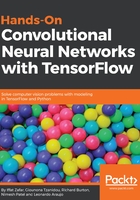
Feeding data with placeholders
Placeholders are Tensor-like objects. They are a contract between you and TensorFlow that says when you run your computation graph in a session, you will supply or feed data into that placeholder so that your graph can run successfully.
They are Tensor-like objects as they behave like Tensors, meaning you can pass them around in places where you would put a Tensor.
By using placeholders, we can supply external inputs into our graph that might change each time we run our graph. The natural use for them is as a way to supply data and labels into our model as the data and labels we supply will generally be different each time we want to run our graph.
When creating a placeholder, we must supply the datatype that will be fed.
We will use two placeholders to supply data and labels into our graph. We also supply the shape that any data fed into these placeholders must take. We use None to indicate the size of that particular dimension can take any value. This way we are able to feed in batches of data that are varying sizes. Following we'll see how to define placeholders in TensorFlow for our problem.
x = tf.placeholder(tf.float32, shape=[None, 4], name="data_in") y = tf.placeholder(tf.int32, shape=[None, 3], name="target_labels")
Now, we have created placeholders in our graph, so we can construct our linear model on the graph as well. We call our function that we defined previously, and supply as input our data placeholder, x. Remember, placeholders act like Tensors so they can be passed around like them as well. In the following code we call our linear_model function with our placeholder as the input argument.
model_out = linear_model(x)
When we call our function, everything inside it executes and all the ops and variables are added to our TensorFlow graph. We only need to do this once; if we were to try calling our function again, we would get an error saying that we have tried to add variables to the graph but they already exist.
Placeholders are the simplest and quickest way of supplying external data into our graph, so it's good to know about them. Later on, we will see better ways of supplying data using the dataset API, but for now placeholders are a good place to start.